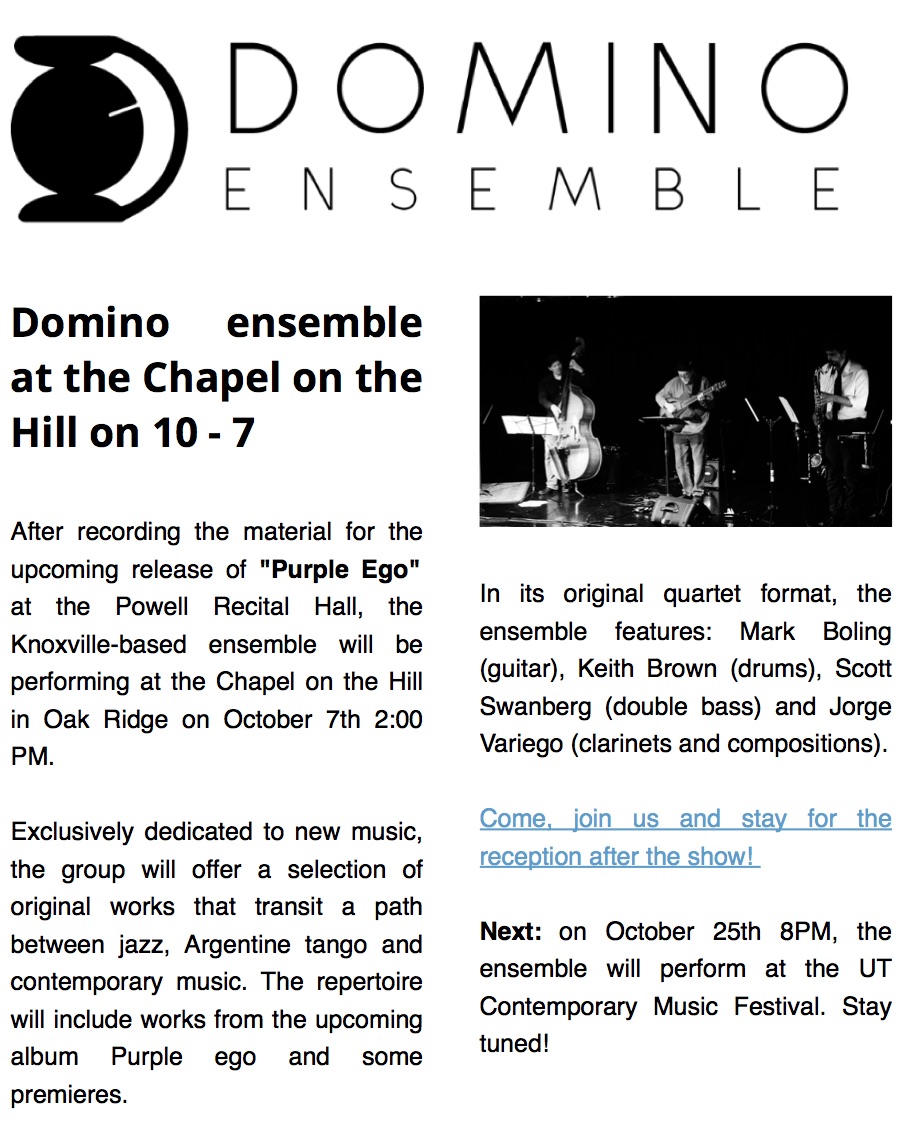
Under the direction of Keith Aleo, the Interlochen Center for the Arts Percussion Ensemble (Jonathan Lucke marimba, Eva Machado marimba and Ruyi Yuan vibes) will perform my piece Le Grand Bolonqui on November 2nd. Here is the concert program, I couldn’t be happier to be part of this event!
Interlochen Arts Academy Percussion Ensemble – Nov 2, 2018 – 730PM
CONCERT PROGRAM:
Corporel – Vinko Globokar
Prelude (Aria I) from Threads – Paul Lansky
Extremes – Jason Treuting
Shared Space – Ivan Trevino
La grand bolonqui – Jorge Variego
Spine – Michael Laurello
Percussion ensemble
Jakob Schoenfeld
Anne Hayes
Eli Reisz
Ava Machado
Abigail Dellovade
Jaelyn Quilizapa
Jonathan Lucke
Zhaohan Pan
Ruyi Yuan
Yizhang Qiang
Kyle Skarshaug
Sophia Bondi
Program notes:
Corporel – Vinko Globokar
Trombonist and composer Vinko Globokar (b. 1934) began as a jazz musician in Yugoslavia before studying composition in Paris and later in Berlin, with René Leibowitz and Luciano Berio respectively. His work can be distinguished by a generally energetic, spontaneous, and especially experimental nature, often incorporating extended instrumental techniques and blending extra-musical elements (movement, speech, theater, politics, etc.) into performance. The relationships between and roles of composer(s) and performer(s) have also provided Globokar a great source of interest, and as a performer, one can expect a certain level of freedom (or a required amount of personal involvement and contribution, depending on one’s perspective) when approaching his compositions. ?Corporel is for a percussionist, performed on his or her body.
Prelude (Aria I) from Threads – Paul Lansky
Threads, written for Sō Percussion in 2005, is a half-hour long “cantata” for percussion quartet in ten short movements. There are three “threads” that are interwoven in the piece: Arias and Preludes that focus on the metallic pitched sounds of vibraphones, glockenspiel and pipes; Choruses in which drumming predominates; and Recitatives made largely from Cage-like noise instruments, bottles, flower pots, crotales, etc. The aim of the different threads is to highlight the wide range of qualities that percussion instruments are capable of, from lyrical and tender to forceful and aggressive, and weave them into one continuous “thread”. The movements are performed without interruption. – Paul Lansky
Extremes – Jason Treuting
With Extremes, composer Jason Treuting bypasses traditional music notation altogether, creating a system in which consonants and vowels contained in the six city names of Denver, Helena, Burlington, Brooklyn, Houston, and Cleveland receive either a short or long rhythmic duration (eighth note versus dotted-eighth, respectively). With a steady quarter note pulse shared amongst the four players, entire sections of music are developed in which the six city names are placed in cannon – recall the precise same musical process as Row) Row) Row Your Boat. In other moments, two players perform a series of chords, in 7 /8 time, atop a rhythmic ostinato established by the very opening loop of “Denver/ Helena”. Extremes is part of a larger, evening length work entitled “Imaginary City”, composed by Treuting and realized by So Percussion.
Shared Space (2015) was commissioned by McCallum High School Percussion Ensemble for their 2015 Percussive Arts Society International Convention showcase concert. The piece is scored for seven percussionists who share a setup of one 5.0 octave marimba, one vibraphone, one glockenspiel, one cajon, and toms. At times, up to five players perform on the same keyboard instrument, some standing on the opposite side of the instrument, creating a challenging and fun learning and performing experience.
The idea of community is deeply embedded in the music world. We as musicians do best when we support one another and our projects. I’ve developed this kind of relationship with McCallum High School’s music program. The school is located just blocks from my home in Austin, TX. In the fall, during my morning coffee run, I can hear the McCallum drumline warming up in the distance. We’re that close. I’ve coached their percussion ensembles; they’ve hosted my band for concerts. I’ve given clinics there; they’ve let me utilize their rehearsal rooms. It really is a shared space, a shared understanding of supporting what we do as artists.-Ivan Trevino
Le Grand Bolonqui (2018)
Triggered by the sound of Takemitsu’s Rain tree, Le grand bolonqui proposes a sonic world of rhythmic densities and sonic blocks that intertwine to create a constantly changing texture.
For moments, the three performers are in different worlds, chasing and following each other. In other sections, they play in strict synchronicity creating the illusion of a single, much larger instrument.
The work ends with an introspective melody that brings the apparent disorder to a final repose. -Jorge Variego
Spine was composed in 2014-15 for the Yale Percussion Group, featuring Yifei Fu. A single line—Yifei’s part—runs through most of the piece, and virtually all of the musical material is derived from it. This meta-line serves as the spine of the music, both in structural terms (backbone), but also with respect to the line’s perceived control over the direction and progression of the music (central nervous system). The music played by the other three members of the quartet serves to color and punctuate the main line. However, over the course of the work, players drift in and out of agreement with one another, and occasionally the primary line loses its unique identity within the texture of the ensemble. I tried to impart an almost biological sense to the way motives grow, attempting to balance intuitive—almost improvisatory—types of development with more structured patterns and processes. -Michael Laurello



 Classical guitar music is always special. A classical guitar ensemble with 12 musicians playing guitars that range from high soprano to low contra-bass guitars, ukuleles and mandolins is very special indeed.
Classical guitar music is always special. A classical guitar ensemble with 12 musicians playing guitars that range from high soprano to low contra-bass guitars, ukuleles and mandolins is very special indeed.

